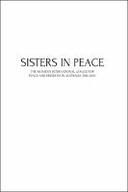Explore

Is preparing for war the best means of preserving peace? In
Sisters in Peace, Kate Laing contends that this question has never been solely
the concern of politicians and strategists. She maps successive generations of
twentieth-century women who were eager to engage in political debate even though
legislative and cultural barriers worked to exclude their voices. In 1915,
during the First World War, the Women's International Congress at The Hague
was convened after alarmed and bereaved women from both sides of the conflict
insisted that their opinions on war and the pathway to peace be heard. From this
gathering emerged the Women’s International League for Peace and Freedom
(WILPF), which to this day campaigns against militarism and nuclear weapons. In
Australia, the formation of a section of WILPF connected political women to a
worldwide network that sustained their anti-war activism throughout the last
century. In examining the rise of WILPF in Australia, Sisters in Peace provides
a gendered history of this country’s engagement with the politics of
internationalism. This is a history of WILPF women who committed to peace
activism even as Australia’s national identity and military allegiances shifted
over time—a history that has until now been an overlooked part of the Australian
peace movement.
This book is included in DOAB.
Why read this book? Have your say.
You must be logged in to comment.
Rights Information
Are you the author or publisher of this work? If so, you can claim it as yours by registering as an Unglue.it rights holder.Downloads
This work has been downloaded 69 times via unglue.it ebook links.
- 69 - pdf (CC BY-NC-ND) at Unglue.it.
Keywords
- anti-war
- Australasian & Pacific history
- Australia
- History
- Humanities
- Internationalism
- Peace
- Political activism
- Politics & government
- Regional & national history
- Social discrimination & inequality
- Social issues & processes
- Society & culture: general
- Society & Social Sciences
- thema EDItEUR::J Society and Social Sciences::JB Society and culture: general::JBF Social and ethical issues::JBFA Social discrimination and social justice
- thema EDItEUR::J Society and Social Sciences::JP Politics and government::JPW Political activism / Political engagement
- thema EDItEUR::N History and Archaeology::NH History::NHM Australasian and Pacific history
- WILPF
- Women
Links
DOI: 10.22459/SP.2023Editions

